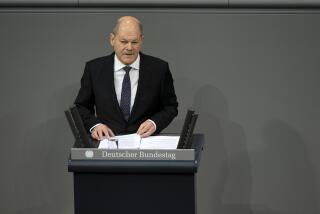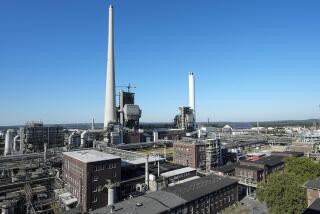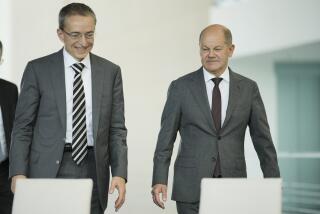Uniting German Economies Will Cost Billions
- Share via
BONN — In a development likely to alter the balance of economic power in Europe and beyond for the foreseeable future, East and West Germans have started the enormous task of unifying their economies.
The initial, unofficial cost estimates are staggering. While neither the East nor West German governments have made official projections, some of West Germany’s most respected economists have suggested the final price tag for unification could easily top 1 trillion deutschemarks (more than $600 billion).
“If you assume that you are going to bring (East Germany) up to a similar level as ourselves, then this could pass the 1-trillion level,” said Gerhard Fels, director of the respected Institute for the German Economy in Cologne.
Hans-Juergen Schmahl, head of the Hamburg Institute for Economic Research, recently gave a similar projection.
Such a program would likely take well over a decade to complete. And for the Germans, and for their partners in the global trading community, the stakes in fusing the world’s fourth- and 13th-largest economies could not be higher.
Mismanaging such a radical overhaul could drag West Germany into a kind of economic Vietnam, undermining Europe’s most powerful economy and severely weakening the deutschemark, one of the world’s pivotal currencies.
However, if the ambitious program succeeds--and a surprising number of knowledgeable West Germans are confident it can--a more powerful Germany will emerge with significantly higher growth rates, a far larger domestic market and an even greater export potential. (Last year West Germany on its own was the world’s second-largest exporter, just behind the United States.)
On Saturday, Chancellor Helmut Kohl of West Germany said optimistically that his country is rich enough to pay for rebuilding East Germany without levying extra taxes, Reuters news agency reported. Kohl also reiterated his hope that the deutschemark can become East Germany’s official currency by early summer to reassure East Germans that their ailing economy will be propped up.
A united Germany, with 25% more economic muscle, can only extend the influence of German policy on Europe as a whole, analysts agree.
“That influence is already there and will grow once (Germany) gets bigger,” said Alan Budd, chief economic adviser to Barclays Bank in London.
The sheer size of the East German reconstruction program will reshape the world economy, turning West Germany, one of the world’s largest exporters of capital, into a net capital importer.
West Germany’s huge trade and budget surpluses also could disappear as both its own production and that of other nations are needed to meet the demand.
Indeed, Economics Ministry officials here fret openly about how to dispel the myth that West Germany can accomplish such a huge program on its own.
“We’ve got to get others to be a part of this,” said Gerhard Ollig, a member of the ministry’s hastily assembled “Germany staff,” which is supervising part of the reconstruction planning.
Some see it as ironic that the realization of the dream of unification will effectively force West Germany into the role of an economic locomotive--a role long advocated by U.S. policy-makers as a way of stimulating world trade but always resisted by cautious West Germans as inflationary.
The need for such a huge and rapid commitment of funds reflects the complex realities facing the two Germanys. West German policy-makers see it as politically impossible to rebuild East Germany on anything other than an equal footing with its Western cousins.
“Our goal is a Germany where the steelworker in Rostock or the pensioner in Dresden (both East German cities) on the average have just as high an income as those in (West German) Duisburg or Stuttgart,” West German Labor Minister Norbert Bluem declared recently.
The program also must start quickly to instill confidence in a demoralized East German population increasingly anxious about its future. Anything less would be hard to defend politically and would fail to halt the potentially destabilizing population shift from East to West that has so strained West Germany’s affluent, yet fragile, social cohesion. More than 150,000 East Germans have fled to the West so far this year.
Many decisions are delicate and loaded with risk. Fixing East German wage levels in deutschemarks too low following the expected currency union could increase the potentially destabilizing flow of refugees, while setting them too high could trigger damaging inflation.
“There is no precedent for what we are trying to do,” said West Germany’s deputy government spokesman, Dieter Vogel. “It has to be done just right.”
The task itself is daunting. Among the most pressing needs for East Germany:
* An estimated $20 billion to $30 billion to restructure an electricity sector that today runs mainly on air-polluting brown coal, loses nearly one third of its production on the way to the consumer and sports the world’s third-highest unit costs.
* An estimated $100 billion or more to clean up an environment generally accepted as among the most polluted in the industrialized world. Unibert Schwarz, a leading economist at East Germany’s Central Institute for Economics, a branch of the National Academy of Sciences in East Berlin, said in an interview that pollution levels of East Germany’s chemical industry are so high that the cost of environmental damage probably exceeds the value of the industry’s entire production.
“There are plants we not only have to close but need to dig a hole and bury like some kind of nuclear waste,” Schwarz said.
* An estimated $60 billion to electrify the remaining three quarters of East Germany’s creaking rail network, to replace decaying track and to upgrade rolling stock. Once completed, the new rail links will give German industry the most modern, efficient access into the potentially rich markets of Eastern Europe and the Soviet Union.
* An estimated $60 billion to $70 billion to upgrade public housing in a country where one in three dwellings remains without running water and sewerage.
The cost of restructuring East German industry is incalculable but is likely to run into the hundreds of billions of dollars.
With little detailed available information about the value of the 221 national and regional combines that make up East German industry, no one is yet sure about the exact size of the undertaking.
Horst Lambrecht, an East Germany specialist at West Berlin’s German Economic Institute, judged that a quarter to a third of the East German industrial sector is unsalvageable. In the country’s inefficient agricultural sector, the situation is even worse, he estimated.
Policy planners here worry about the unemployment shock when industries that for years have produced obsolete, unwanted goods for captive customers hit the brick wall of competition.
The introduction of the West German deutschemark into East Germany, now planned for around midyear, will offer the East German consumer a choice of goods for the first time, and East German products are expected to fail on both cost and quality grounds.
On Saturday, West Germany’s central bank recommended a 2-to-1 conversion rate for East German currency.
However, some members of Chancellor Kohl’s governing coalition immediately attacked the proposal, and heavy criticism was reported in East Germany as well. Critics said a 2-to-1 rate--exchanging two East German ostmarks for every one West German deutschemark--would erode the life savings of elderly East Germans and deny workers a chance to earn decent wages.
In parts of the automotive, chemical and consumer electronics industries and in the agricultural sector, as much as 80% of the work force may face layoffs as demand plummets. Nationally, planners are bracing for East German unemployment rates of up to 25% during the reconstruction phase.
The size of the task of reviving East Germany’s economy reflects the totality of the failure of centrally planned Marxist economies. It also provides a hint of the investment needed to integrate the former Soviet Bloc nations into a more unified Europe.
While the inferiority of such systems has long been accepted, East Germany was always considered communism’s success story. Conditions there have come as a genuine shock.
Although there are signs of concern on global financial markets that the West Germans might damage their own economy in trying to rebuild the East, West German economists--themselves notorious worriers--are uncharacteristically upbeat.
As key reasons for this optimism, they point to a mixture of West German capital, a cadre of East German managers eager to adopt Western practices, and a disciplined, well-trained work force hungry for a share of Western affluence. They note that Japan, South Korea, Taiwan and Spain all grew far faster than expected under similar conditions.
Fels and other economists also dismiss fears that Kohl’s government could be forced to implement crippling tax increases to finance the recovery program. They note that West Germany’s own “economic miracle” of the 1950s and 1960s was largely self-financed after an initial infusion of $1.7 billion in U.S. Marshall Plan aid--and that the same could occur in East Germany.
Some anticipate substantial funds will arise from the sale of state-owned property in a country where the state claims ownership of both industry and the land.
Crucial in this process, however, is that East Germany’s new government moves swiftly to encourage private investment. Laws permitting private enterprise, private property and free collective bargaining under conditions similar to West Germany are urgently needed if the recovery program is to start quickly.
More to Read
Sign up for Essential California
The most important California stories and recommendations in your inbox every morning.
You may occasionally receive promotional content from the Los Angeles Times.












